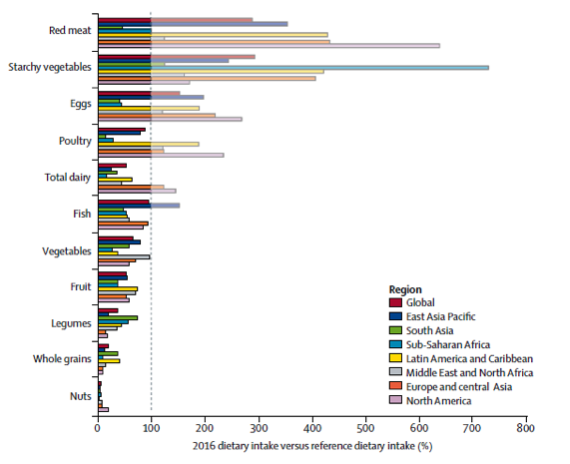Assessing foods for healthy bodies on a healthy planet

Our food system—how we produce and consume food—is currently harming our planet and us, and is the single largest reason we have breached planetary boundaries, which define a safe operating space for humanity. More specifically, the way we produce and consume food is driving deforestation, reducing biodiversity, emitting huge amounts of greenhouse gases (27% of global greenhouse gas emissions), and degrading soils, amongst others. From a human health perspective, the sector is also responsible for the paradoxical coexistence of malnutrition and obesity, with more than 50% of the Europeans classed as overweight, and more than 20% as obese. As a result, the key challenge for Europe and other developed regions are to deliver better nutrition while reducing environmental impact. My research is part of the EU Horizon 2020 TRUE project, which aims to identify the transition paths to increase sustainable production and consumption of legumes in Europe.
An ode to legumes
Why legumes? First, the meaning of the term “legume” is different from that of the term “vegetable”. Legumes are the plants from the Fabaceae family, and common ones are chickpeas, lentils, faba beans, peas, green beans, soybean, and clover. They are the forgotten heroes of food, the kings of environmental sustainability, and the saviours of nutritional security. They are virtuous in their capability to fix atmospheric nitrogen in the soil thanks to their symbiotic relationship with specific soil bacteria. Nitrogen is an essential nutrient for amino acid synthesis, and therefore for plant growth. Nitrogen Use Efficiency (NUE) represents the amount of nitrogen that is being taken up, assimilated, and remobilised by the plant. NUE is higher when legumes are inserted in crop rotations than when synthetic nitrogen fertilisers (SNFs) are used instead of legumes. SNF production is associated with high environmental burdens, and its over-application contributes to nutrient pollution in freshwater, soil, and marine environments. Other ecological benefits of legume crops are biodiversity increase, weed management, disease prevention, and yield boosting.
“They are the forgotten heroes of food, the kings of environmental sustainability, and the saviours of nutritional security”
From a nutritional perspective, legumes are a rich source of many macro- and micro-nutrients, such as fibre, protein, low glycaemic carbohydrates, phosphorus, magnesium, B vitamins, iron, copper, manganese, and zinc. Fibre, for example, is a key nutrient lacking in Western diets, which are characterised by the disproportioned intake of highly processed, energy-rich but nutrient-poor foods. Benefits of legume consumption include weight management, lower cholesterol and blood pressure control, and gut health improvement.
Despite their environmental and nutritional virtues, as well as their comparatively low cost, legumes are scarcely grown and consumed in Europe. Legumes are cultivated on only 2.1% of Europe’s arable land, a sharp contrast with the 54% arable land allocated to cereals. Moreover, they are unpopular amongst consumers, and merely represent 1% of calorie intake of the average European, and are largely under-consumed in the rest of the world too (Figure 1).
Figure 1: Dietary patterns and their differences with the EAT Lancet reference healthy and environmentally-sustainable diet (Figure from Willett et al., 2019).
Increasing legume popularity
So how can we make legumes more popular? Recently, an explosion of innovative legume-based products that mimic popular foods emerged in the market, increasing convenience and helping consumers see legumes in a familiar context. However, how can we be sure that these processed products are actually healthier and more environmentally-friendly than their traditional alternatives? And if they are, by how much?
Answering this question is the aim of my PhD research. I work with some of the innovative food companies producing legume-based food products, quantifying their environmental footprint per nutritional delivery. To put this into perspective, I compare their relative performance with that of their traditional alternatives, such as burger patties made from legumes or beef. I use a Life Cycle Assessment (LCA) approach, comparing foods from cradle to fork, which ensures that all inputs and outputs that matter are considered, such as: yield, fertiliser, diesel, packaging, electricity, and waste. My assessments do not only include carbon footprint, as major trade-offs can be hidden when looking at this environmental issue only. In total, I compare foods across sixteen environmental issues, such as water scarcity, land use, resource depletion, and nutrient pollution.
The key message of the approach I am taking is that it is improper and unfair to compare the environmental footprint of any products on a serving basis (one vegetarian versus one beef burger patty). In order to inform policy and decision makers, it is crucial to compare the environmental footprint of foods based on how much nutrition they deliver, as this is the key function of food, and we are clearly not following the right diet. Pointing out which foods are healthy is key, like this chickpea pasta, for example, which is 2.6 times more nutrient-dense than a typical durum wheat pasta, and delivers 3.2 times more fibre, 1.5 times more protein, and 8 times more essential fatty acids.
“In order to inform policy and decision-makers, it is crucial to compare the environmental footprint of foods based on how much nutrition they deliver, as this is the key function of food”
Why should we then compare the environmental impact of a serving of chickpea versus a serving of wheat pasta? Ultimately, if you do not receive proper nutrition from a food, your body will need additional nutrients. Those additional nutrients will come from additional food consumption, which will result in additional environmental impacts. If you cannot gain access to additional food to consume, you will suffer from malnutrition.
Key obstacles of food manufacturing companies and consumers to achieve sustainability
I have realised during my PhD research that food manufacturing companies who want to quantify, improve, and communicate their sustainability impacts face huge costs and time issues, as individual life cycle assessments of their products require a lot of resources: time, money, and effort. Therefore, the evaluation of the environmental impact of individual food products is rarely performed. However, sustainability should not be a luxury. As a result, consumers have to rely on their own assumptions when wanting to buy foods that are both healthy and environmentally-friendly, due to the absence of complete and trustworthy information. Even though general assumptions can be made, such as any legume will have a lower environmental impact than any beef, there are huge variations between products within a same category, due to the wide possible practices across the life cycle of a product, from cultivation to processing, packaging, distribution, consumption and disposal.
“Consumers have to rely on their own assumptions when wanting to buy foods that are both healthy and environmentally-friendly, due to the absence of complete and trustworthy information”
If a buyer looks at a label in the supermarket, she/he will face a plethora of, typically, incomplete information and—with time and knowledge constraints—will probably make the wrong decision. Let us look, for example, at the British nutritional label. For an individual with no specifically known medical issue, how can he decide which is worse, high salt or high sugar? And, because only the presence of unhealthy nutrients is shown, one misses the indication of which food actually brings positive nutrition. The French Nutri-score is more adapted in this regard, as it aggregates all nutritional information (healthy and unhealthy nutrients) into a single score, however it does not inform on the environmental impact of the product. Many consumers think that local and organic is better than imported and non-organic, however again it all depends on the inputs and outputs involved in the production of individual products.
In the same vein, environmental labels are incomplete, such as the Carbon Trust label looking only at the carbon footprint. Moreover, with the presence of both an environmental and nutritional label, you would have to combine both scores, and again, how will you decide which is better? Let us face it: numerous consumers do not take the time to consider each product they buy at the supermarket, so a label aggregating all this information into a single score will save a lot of time and thinking!
British nutritional label
French nutritional label
Carbon Trust carbon dioxide label
Translating research into practice: Econut
Therefore, my PhD research partner and I came up with an ambitious idea that we are currently developing: Econut! Econut provides a software that overcomes the problem of cost, scalability, and complexity for food companies to measure, improve, and communicate the environmental and nutritional sustainability performance of their individual products. Thanks to Econut, food companies can assess all of their products in an automated way, identify hotspots, and simulate different recipes indefinitely to measure any changes they would incur. After a data refining and a third party auditor, the Econut label placed on the packaging will empower consumers to make the right choice easily in an instant, as well as getting detailed information if they want to know more, by scanning the QR code on the label.
We are taking part in the EIT Global Food Venture Programme, which supports PhD students who are passionate about food sustainability and want to translate their ideas into start-ups. This 6 months programme offers training bootcamps, mentors, a huge network, and a final pitch competition, at no financial cost. I recommend it highly. We have had some amazing speakers and our entrepreneurship approach evolved greatly since we first started. We are now in the process of registering the start-up legally, and having validated the need and want from food companies to acquire the software, we are currently developing a first prototype. What is next? Testing the software with a few companies, and using our financial resources to develop further the software, to ensure product-market fit. We are also applying to receive funding from the European Green Deal, which fits perfectly with Econut’s vision. We believe Econut has the power to revolutionise the food industry, inciting food companies to provide more nutritious and sustainable foods, and finally letting consumers know what they eat.
Econut Label
By Sophie Saget
November 2020
Sophie Saget
Sophie Saget is a PhD Candidate in Food Sustainability at Trinity College Dublin (Ireland). She works on assessing the environmental sustainability of legume-based foods and comparing them with their traditional alternatives, integrating nutrition into the equation. Before this, she studied Biotechnology with Management at the University of Edinburgh (Scotland), where she discovered her love for legumes. She is a co-founder of Econut, a startup that aims to revolutionise environmental and nutritional sustainability monitoring for food companies.






